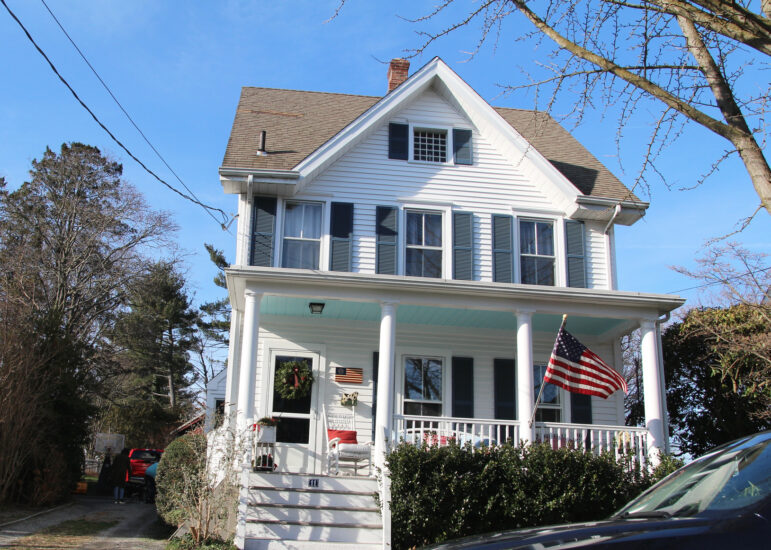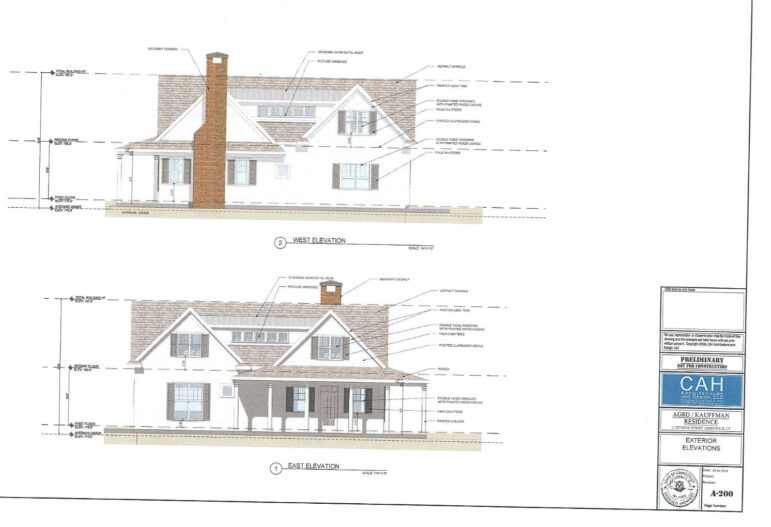In November the Greenwich Planning & Zoning commission voted unanimously to rezone a property at 11 Division Street in the Town’s historic Fourth Ward from the R-6 zone to R-6 HO zone.
HO stands for Historic Overlay.
The commission found that the applicant had met the standards of Greenwich’s Building Zone Regulations, (Section 6-109), on Historic Overlay, and approved the construction of a second house on the property, in exchange for deed restricting the historic structure (built around 1885) in perpetuity.
On October 16, the Historic District Commission, which is advisory to P&Z, stipulated that vinyl siding be removed and the “present structure must be taken back to its original siding…”


Fast forward to the Dec 15 P&Z Zoom meeting when the applicants, Tracey Kauffman and Dan Agro, said that the stipulation that they remove the vinyl was a deal breaker for them, and had they known their architect would agree to it, they would not have approved.
The couple replaced 40-year-old vinyl siding in 2019 with vinyl siding, trim and shutters.
In a letter on file Kauffman referred to the siding as “state of the art wood-looking vinyl.”

Kauffman and Agro said they spent considerable money re-siding their house in vinyl and wanted relief from the stipulation.
Kauffman’s letter says she and her husband hoped to retire in the Fourth Ward where they have lived for 30 years, but the old house has steep stairs and no downstairs bedroom or bathroom.
She said they hoped to use the Historic Overlay incentive to tear down a garage built in 1940 and construct a second house that would include a downstairs bedroom and bathroom. They would then rent out the original, historic house.
“To go to the expense of putting on new siding at this stage is wasteful and onerous given our recent investment,” Kauffman wrote. “We are hoping that the Commission will allow us to proceed with our project with the understanding and agreement that when the time comes to install new siding on the original home, that we will work with the Historic District Commission.”
Kauffman wrote that her architect represented her and her husband at HDC without their knowledge and agreed to stipulations without their approval.
“He agreed to conditions that make the project no longer viable,” she wrote. “Our biggest fear is that if we don’t get to build our modest cottage in the back, our beautiful old home will be sold and torn down or expanded into a new horrible mini mansion.”
She noted that the house was built around 1885 in Farmhouse style with Queen Anne detailing.
“Some distinctive features include a centralized brick chimney, clapboard siding, window shutters, raised open front porch with spun columns and a steep pitched cross gabled roof and original windows,” she wrote.
“We have all antique furniture. I collect bottles and antique toys,” Agro told the commission.
Kauffman said members of her family had been Greenwich residents since the founding of the Town, and that she is a member of the Daughters of the American Revolution.
The historic value of the house at 11 Division Street was featured in a 1985-86 inventory of historic properties in town, compiled by consultant Nils Kerschus.
Kerschus wrote that Patrick Gorman, an immigrant from Caludy, Ireland, who worked on the nearby Milbank Estate as caretaker, purchased the lot in 1885.
“The appeal of being within the Borough (of Greenwich) as well as in close proximity to St. Mary’s Church, the first Roman Catholic Church in Town located at today’s intersection of William and Church streets (present day park and playground),” Kerschus wrote.
“His home was always a haven to his friends and others from his native land,” Kerschus wrote, adding, “Judging by the 1910 census, 5 individuals (non-family members who were born in Ireland and had immigrated) were boarding at 11 Division Street along with three generations of the Gorman family.”
Kerschus also wrote that Mr. Gorman was a high-ranking member of the Ancient Order of Hibernians, Knights of Columbus, Satisfied Club (Port Chester [sic], Orinoco Council and his funeral was one of the largest had in Greenwich in some years.”
In 1920, Mr. Gorman’s widow, Bessie, sold the house and lot to Walter Fogg, son of Irish immigrants.
Kerschus wrote that Fogg had been a butter and egg salesman whose formal education ended at eighth grade. Shortly after he bought 11 Division Street he started Fairview Farms, while on Northfield Street Round Hill Dairy Company purchased land for its dairy machinery.
In the end, the P&Z commission referred the applicant to the Historic District Commission for their opinion.
The HDC is advisory to P&Z. Then the applicants will later return to the P&Z commission.
“We want to be supportive, but we don’t want to turn our backs on HDC,” Alban said.
The applicants would tentatively appear before HDC in January.